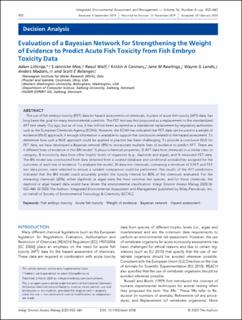Evaluation of a Bayesian network for strengthening the weight of evidence to predict acute fish toxicity from fish embryo toxicity data
Lillicrap, Adam David; Moe, Jannicke; Wolf, Raoul; Connors, Kristin A.; Rawlings, Jane M.; Landis, Wayne G.; Madsen, Anders L.; Belanger, Scott E.
Peer reviewed, Journal article
Published version
Permanent lenke
https://hdl.handle.net/11250/2678265Utgivelsesdato
2020Metadata
Vis full innførselSamlinger
- Publikasjoner fra Cristin - NIVA [2160]
- Scientific publications [1172]
Originalversjon
Integrated Environmental Assessment and Management. 2020, 16 (4), 452-460. 10.1002/ieam.4258Sammendrag
The use of sh embryo toxicity (FET) data for hazard assessments of chemicals, in place of acute sh toxicity (AFT) data, has long been the goal for many environmental scientists. The FET test was rst proposed as a replacement to the standardized AFT test nearly 15 y ago, but as of now, it has still not been accepted as a standalone replacement by regulatory authorities such as the European Chemicals Agency (ECHA). However, the ECHA has indicated that FET data can be used in a weight of evidence (WoE) approach, if enough information is available to support the conclusions related to the hazard assessment. To determine how such a WoE approach could be applied in practice has been challenging. To provide a conclusive WoE for FET data, we have developed a Bayesian network (BN) to incorporate multiple lines of evidence to predict AFT. There are 4 different lines of evidence in this BN model: 1) physicochemical properties, 2) AFT data from chemicals in a similar class or category, 3) ecotoxicity data from other trophic levels of organisms (e.g., daphnids and algae), and 4) measured FET data. The BN model was constructed from data obtained from a curated database and conditional probabilities assigned for the outcomes of each line of evidence. To evaluate the model, 20 datarich chemicals, containing a minimum of 3 AFT and FET test data points, were selected to ensure a suitable comparison could be performed. The results of the AFT predictions indicated that the BN model could accurately predict the toxicity interval for 80% of the chemicals evaluated. For the remaining chemicals (20%), either daphnids or algae were the most sensitive test species, and for those chemicals, the daphnid or algal hazard data would have driven the environmental classication. Integr Environ Assess Manag 2020;16: 452–460. © 2020 The Authors. Integrated Environmental Assessment and Management published by Wiley Periodicals, Inc. on behalf of Society of Environmental Toxicology & Chemistry (SETAC)

